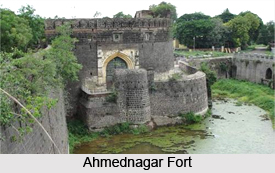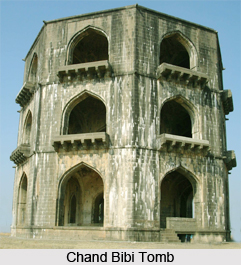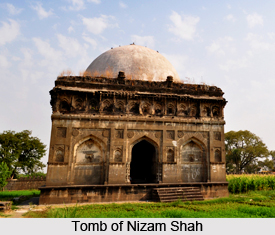 The monuments of Ahmednagar are magnificent constructions mainly built by the rulers of the Nizam Shahi dynasty. The town was founded by Ahmad Nizam Shah in 1494 on the site of an earlier settlement. The Nizam Shahi dynasty of Ahmadnagar beautified the city of Ahmednagar by means of a number of architectural works of art, such as forts, palaces, mosques etc. Situated on the flood-plain of the Sina River, the town was Ahmednagar became the centre of a powerful state under the Nizam Shahi dynasty. They went on to build, renovate and fortify the place and subsequently, it was the only state on the west coast of India to maintain control in the face of Portuguese piracy.
The monuments of Ahmednagar are magnificent constructions mainly built by the rulers of the Nizam Shahi dynasty. The town was founded by Ahmad Nizam Shah in 1494 on the site of an earlier settlement. The Nizam Shahi dynasty of Ahmadnagar beautified the city of Ahmednagar by means of a number of architectural works of art, such as forts, palaces, mosques etc. Situated on the flood-plain of the Sina River, the town was Ahmednagar became the centre of a powerful state under the Nizam Shahi dynasty. They went on to build, renovate and fortify the place and subsequently, it was the only state on the west coast of India to maintain control in the face of Portuguese piracy.
A number of monuments are found in Ahmednagar of both historical and religious interest.
Historical Monuments of Ahmednagar
Chief among the historical monuments are the fort and Farah Baksh palace. To the East of the city at a distance of about 800 miles is the fort built by Husain Nizam Shah in 1559. The main entrance is protected by a powerful circular bastion. In plan the fort is more or less circular in shape and almost 533 ft in circumference. Built of dressed ashlar up to the level of the wall-walk, the outer wall is crenellated with embrasures that are about 60 ft high with a glacis to the outer ditch. Twenty-two circular bastions, including one which is three-lobed, reinforce the defences.
The fort was taken over by Akbar in 1599. Later it was taken from the Nizam by the Marathas. In 1797 the fort was assigned to Daulat Rao Scindia, from whom it was captured by Lord Wellesley on 12 August 1803.
The construction of the Farah Bakhsh Palace was started in 1508, completed in 1574 and rebuilt in 1583.It is mostly in ruins now.
The buildings around the Niamat Khani, which were erected between 1576 and 1578, are also in a similar state.
 Religious Monuments of Ahmednagar
Religious Monuments of Ahmednagar
The city has an interesting heritage of Islamic monuments. Many mosques, tombs and dargahs are found here, indicative of an Islamic society.
The town is famous as the residence of the historian Ferishta (1570-1611) and as the last resting-place of Emperor Aurangzeb, who died here on 3 March 1707. Alamgir`s Dargah, a small enclosure near the cantonment, marks his final resting-place before his burial at Aurangabad.
The Qasim Mosque (1500-1508) is one of the best. Small and plainly detailed, it is built of dressed stone with two aisles on either side of the nave.
The Husaini Mosque was built by a Persian Shiite who settled here and established a madrasa. The dome of the mosque is spherical and resembles early Persian style, with a broad span carried on a high drum.
The mosque in the Kothla enclosures was constructed in 1536-7 as part of a Shia university under royal patronage. It is a classic example of the flat-roofed technique; built in dressed stone with a heavy eaves cornice over the facade.
The Farhad Khani Mosque built in 1560, has ornamental crestings over the main entrance. A multifoil arch with minarets surrounds the entrance of the courtyard, which has arched chambers and projecting corbelled eaves.
Mecca mosque was built by Rumi Khan, a Turkish officer of artillery under Ahmad Nizam Shah. It was constructed sometime between 1505 and 1525 with trap and limestone masonry. The facade has four unusual polished stone pillars resembling black marble, reputedly brought from Mecca. It may be mentioned here that Rumi Khan is well known for having cast the Malik-i-Maidan cannon at Bijapur.
 During the reign of Uurhan Nizam Shah, flat -roofed structures with taller minarets emerged as a distinct style. The Mosque of Ghulam Ali, near the Gandhi Maidan, is typical of this, with sleek minarets.
During the reign of Uurhan Nizam Shah, flat -roofed structures with taller minarets emerged as a distinct style. The Mosque of Ghulam Ali, near the Gandhi Maidan, is typical of this, with sleek minarets.
The Damadi Mosque, located 800 metres east of the fort, was constructed between 1567 and 1568. It is a small mosque with beautifully carved details and corner piers which carry highly ornamented minarets. The parapet is battlemented with indentures. The carved stonework is superb. Outside the Zenda Gate is the Kari Mosque or Aghi Behizad, with a stilted dome and four high corner minarets.
The Tomb of Nizam Shah, one of the finest and best-preserved buildings in the city, is situated in a large enclosure on the left bank of the River Sina. Inside, enough of the original ornamental stucco work survives for the overall effect to be gauged, including geometric designs and texts from the Holy Quran, once highlighted in gold. The tomb is enclosed by a 10 ft wall with four gates on each side. The facade over the main entrance is decorated with beautifully chased stucco work. Adjacent is a canopy alleged to cover the grave of a redoubtable elephant which rendered invaluable assistance at the Battle of Talikota in 1565 AD against the Vijayanagara Raja.
A number of other Islamic tombs can also be seen, including those of Abdur Rahman Chishti and Rumi Khan. The latter has a stilted dome with a band of petals around the base and a trefoil battlement.
The Tomb of Salabat Khan or the Chand Bibi lies 6 miles east of the city at the summit of a hill. It is an octagonal tomb of three storeys without any inscription.



















